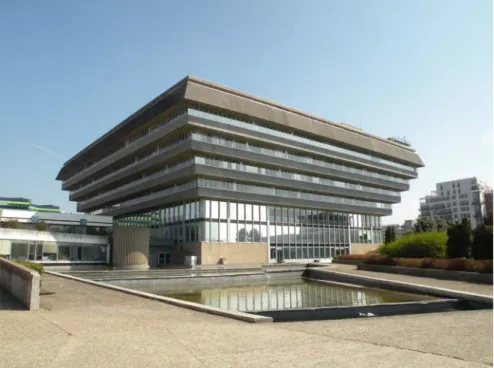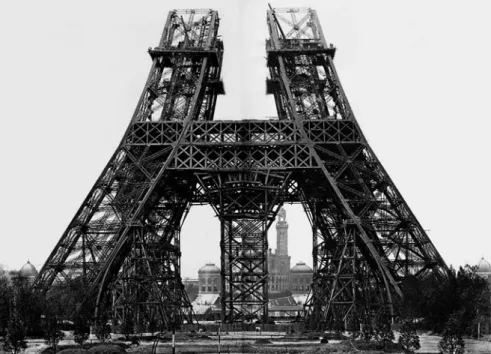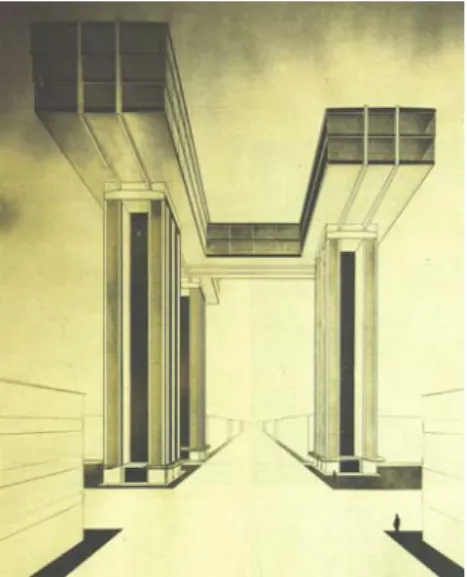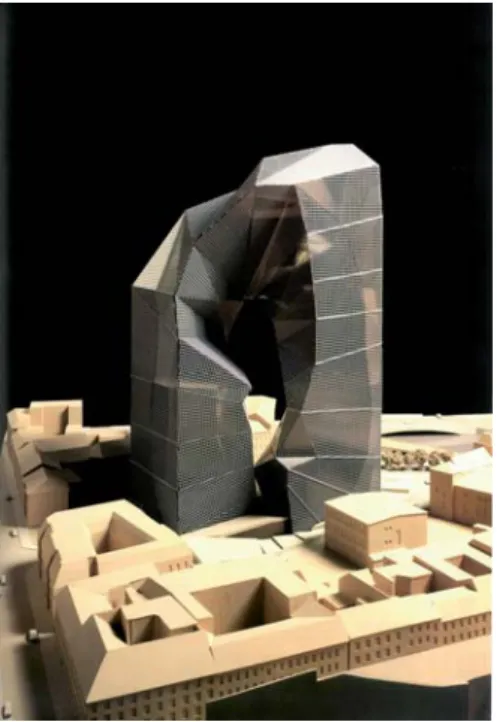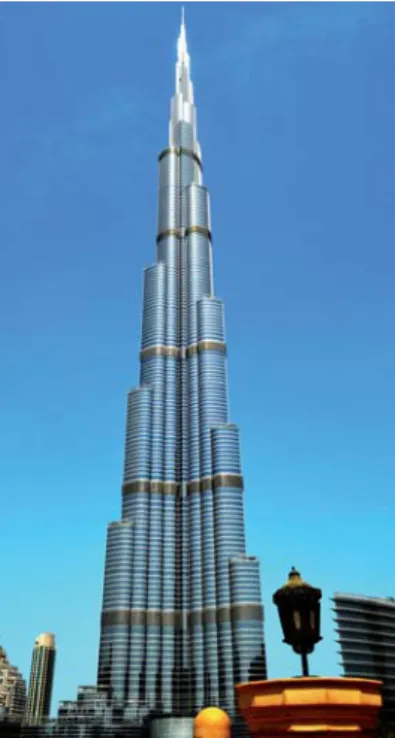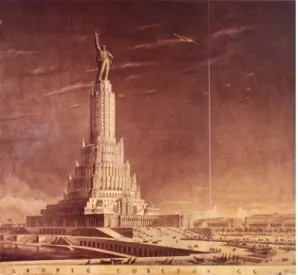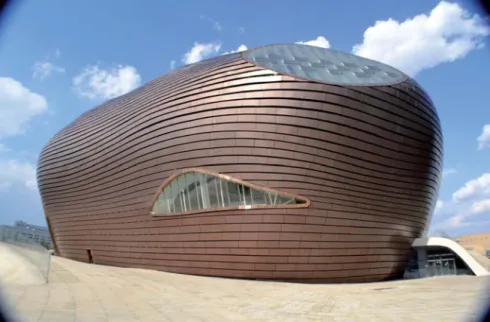Bernd Nicolai
New Monumentalism in Contemporary
Architecture
Abstract: This essay offers an overview of different conceptions of monumental-ism in twentieth- and twenty-first-century architecture. It demonstrates in how much a new radical “Bigness” has become one of the central features of the new globalized architecture over the last two decades. Examining prime exam-ples of contemporary architectural monumentalism, such as Rem Koolhaas and Ole Scheeren’s CCTV-Tower and the Burj Khalifa (former Burj Dubai), as well as exploring examples of the new, worldwide emerging museum architecture, this essay detects a remarkable shift in architectural monumentalism from the para-digm of industrial aesthetics of the first six decades of the twentieth century towards a more liberated, joyful and bizarre architecture that started in the 1970s with postmodern and super-structure conceptions and which reached its climax in the work of Rem Koolhaas after 1990.
Bernd Nicolai, Universität Bern E-Mail: bernd.nicolai@ikg.unibe.ch
A building that is monumental has meaning beyond its form and function. It can be monumental both in its scale and in terms of what it represents. Monuments have been constructed to celebrate important events and people for centuries. Some of these struc-tures still exist and are a part of our culture today; think perhaps of Stonehenge or the pyramids at Giza. Buildings that become synonymous with more than their function, per-haps with a city or a culture, could be described as monumental.1
When in 1995 the Office for Metropolitan Architecture (OMA), i.e. Rem Koolhaas and Bruce Mau, published their huge volume titled S, M, L, XL, a new discourse on“Bigness” and monumentality in contemporary architecture was introduced. Not only was the book massive in scope but also ambitious in its content, as it was written according to the idea of wanting to“fill a book big enough to stun
an ox”.2Already two decades earlier, Koolhaas expressed fascination over New
York’s skyscrapers, such as the Empire State Building or the Rockefeller Center, as well as the Manhattan grid, which offers a rational and consistent scheme for monumental solitary buildings. In his retroactive manifesto “Delirious New York” (1978)3, which made Koolhaas famous both as an artist and theoretician,
he analyzed the culture of“Manhattanism”, bringing together such antagonistic examples as the theme-park of Coney Island and the monumental manifestation of 1930s skyscrapers with the Rockefeller Center at the top. In this context, Kool-haas, together with Zoe Zenghelis, published a visionary gouache, the dystopia of the“City of the Captive Globe”4as mental construction, referring to both built
and unbuilt 20th-century avant-garde structures, including schemes such as Cor-busier’s high-rise buildings as part of his Plan Voisin for Paris (1925), Leonidov’s Moscow Ministry of Heavy Industry (1932), as well as projects of Ludwig Mies van der Rohe and Oswald Matthias Ungers.5 “The City of the Captive Globe”
was not only a reference to an archetypal rationalism, especially to that of his teacher Ungers, but interestingly enough constituted a dispute with the so-called “radical Italians”, such as the architecture firm Superstudio, or the fa-mous British Archigram Group with its industrial based mega-structures.6
Although the “City of the Captive Globe” oscillated between a surrealistic pamphlet and a psychedelic pop art environment, Koolhaas focused mainly on “the unexplored potential of the architectural avant-gardes of the 20thcentury”7
as a starting point for new contemporary architecture, conceived in large/extra-large scale and characterized by new monumentality. In S, M, L, XL, Koolhaas defined monumental the following way:
2 Thomas Schinko & Philippe-Marie Morel, “S, M, L, XL, Rem Koolhaas und Frankreich”, Kri-tische Berichte 27.3 (1999): 20–38, at 20; cf. Rem Koolhaas & Bruce Mau, S, M, L, XL (New York: The Monacelli P, 1995) 23.
3 Rem Koolhaas, Delirious New York: A Retroactive Manifesto for Manhattan (New York: Rizzoli 1978). A new edition was published in Rotterdam: 010 Publisher, 1994.
4 Cf. Dominiques Rouillard, “Rem Koolhaas, Elia Zenghelis: Exodus ou les prisonniers volon-taires de l’architecture 1972”, La Ville, Art et Architecture en Europe, 1870–1993, exh.-cat. Centre Georges Pompidou (Paris: Musées nationaux, 1994) 436–437. Cf. also Terence Riley, “The City of the Captive Globe Project”, Envisioning Architecture: Drawings from The Museum of Modern Art, ed. Matilda McQuaid (New York: The Museum of Modern Art, 2002) 172–173.
5 Robert Gargiani, Rem Koolhaas/OMA, the Construction of Merveilles (Lausanne/London: EPFL P/Routledge, 2008) 15.
6 Cf. Rouillard 1994, “Superstudio”, 434–435; Simon Sadler, Archigram: Architecture without Architecture (Cambridge: MIT P, 2005).
‘Strong’, ‘tough’, and ‘brutal’ are post-War II terms of praise (although used earlier by the Futurists to evoke joy of industrial dynamism and warfare) and often serve as euphemism for‘monumental’ a word which may not yet be used without nervous apprehension. But ‘strong’, ‘tough’, and ‘brutal’ describe qualities presently less gratifying than those now designated by‘crazy’, ‘wild’ and ‘cramp’. The parody tends to become the norm.8
This definition marks a remarkable shift in architectural monumentalism from the paradigm of industrial aesthetics of the first six decades of the 20thcentury towards a more liberated, joyful and bizarre architecture, which started in the 1970s with post-modern and super-structure conceptions and reached a climax in the work of Koolhaas after 1990.
The need for a“New Monumentality” is rooted in a debate on monumental architecture raised by Sigfried Giedion in 1944 in light of the final phase of World War II. It was his perception that the neo-classical “pseudo-monumental-ity”, typical for government buildings in Nazi-Germany, the Soviet-Union or even in Roosevelt’s Washington of the 1930s and 1940s had to be overcome. Instead, Giedion asked for a new form of civic center as representation of demo-cratic communities which could shape the“emotional life of the community”:
Civic centers will originate when cities are not regarded as mere agglomerations of jobs and traffic lights. They will arise when men become aware of the isolation in which they live amidst a kicking crowd, and when the demand for a fuller life, which means com-munity life, becomes irresistible. Comcom-munity life is closely connected with a sense for relaxation, with the urge for another vivifying influence beside the job and the family, an influence capable of expanding men’s narrow private existence. No civilization has existed which did not fulfill the irrepressible longing for institutions where such a kind of broader life could develop.9
The civic center, figuring as an enhancement of the expressionist city crown of the early 1920s,10was intended to not only be monumental in shape like
Cor-busier’s or Luis Kahn’s community buildings projects (Palais of the League of Nations or later the capitols of Chandigarh and Dhaka) but also idealistically represent a harmonious community beyond consumerism. Not by chance did
8 Sigfried Giedion, “The Need for a New Monumentality”, New Architecture and City Planning, ed. Paul Zucker (New York: Philosophical Library, 1944) 549–568. Cf. also José Luis Sert, Fer-nand Léger & Sigfried Giedion,“Nine Points on Monumentality”, Harvard Architecture Review 4 ([1943] 1984): 62–63, and Architecture Culture 1943–1968: A Documentary Anthology, ed. Joan Ockman (New York: Rizzoli, 1993) 27–30.
9 Sigfried Giedion, “The need for a new monumentality”, New Architecture and City Planning, ed. Paul Zucker (New York: Philosophical Library, 1944) 549–568, at 565.
10 Cf. Iain Boyd Whyte, Bruno Taut and the Architecture of Activism. Cambridge Urban and Ar-chitectural Studies 6. (Cambridge: Cambridge UP, 1982); see also Expressionist Utopias: Paradise, Metropolis, Architectural Fantasy, ed. Timothy O. Benson (Berkeley: U of California P, 2001).
Koolhaas perpetuate this ideal at the Venice Architecture Biennale of 2012, titled “Common Grounds”, presenting an exhibit on “Public Works – Architecture by Civil Servants” which showcased civic centers from the Netherlands, France, Italy, the UK and Germany, which were not only designed by anonymous archi-tects who adhered to the principles of Giedion’s “New Monumentality” but which also were conceived for a community that was not yet tainted by globa-lized consumerism: A “heyday of public architecture [as] a short-lived, fragile period of naïve optimism – before the brutal rule of the market economy be-came the common denominator”.11
Despite the questionable statement that these buildings are examples of a more idealistic common sense– they were, especially in France, representations of a normative, centralized, non-participative state building policy and the ne-gative impact these buildings had on their users was thematized in Koolhaas’ Biennale exhibition–, these buildings remain important not merely in terms of their scale, visionary shape and radicalness but as an inspiration for actual de-signs in contemporary architecture – even for the OMA itself.12Notable
exam-ples of Koolhaas’ project, such as the Hôtel de Prefecture du Val-d’Oise, built by Henry Bernard 1967–1970 (Fig. 1), followed closely Giedion’s guideline for a post-war monumentality. However, a few years earlier, in 1972, the architects and theoreticians Robert Venturi and Denise Scott Brown had criticized the same kind of architectonical mega-structures as inadequate representations of a pluralist democratic society. Their criticism was directed at a very similar build-ing as the Hôtel de Prefecture du Val-d’Oise, namely the Boston City Hall (Fig. 2) which was designed by Kallmann, McKinnell and Knowles (1963–1968). This early critique, which was voiced during the transition from modernism to post-modernism, marked a paradigm shift in the debate on monumentality and con-stituted a rejection of any kind of“total designs”, opening up architecture in a more social way for community necessities.13 Aesthetically, Venturi and Scott
Brown propagated a new type of mixed media architecture that gained monu-mentality out of every-day life, like the hotels and casinos of Las Vegas with
11 Reinier de Graaf (OMA), <http://www.archdaily.com/267491/venice-biennale-2012-public-works-architecture-by-civil-servants-oma/>., acc. 13 June 2013.
12 Benedikt Hotze, “Rückgriffe in die Geschichte. Die Bauhistorie auf der 13. Biennale”, Bau-netzwoche 286 (2012): 12–16, at 13–14.
13 Martino Stierli, “‘I am a Monument’. Zur Phänomenologie des Monumentalen in der ameri-kanischen Architekturtheorie der 1960er Jahre”, Mythos Monument. Urbane Strategien in Archi-tektur und Kunst seit 1945, ed. Carsten Ruhl (Bielefeld: transcript, 2011) 99–122, at 105–110. Cf. also Robert Venturi, Denise Scott Brown & Steven Izenour, Learning from Las Vegas (Cam-bridge: MIT P, 1972) 99.
Fig. 1: Hôtel de Prefecture du Val-d’Oise, 1967–1970, Henry Bernard (with Robert Decosse et Pierre Mougin). Photo: Catsam.
their “twinkling lights of the city at night”.14On this understanding, Koolhaas’
project exhibited during the Architecture Biennale in Venice of 2012 becomes even more striking, as he emphasized his own conception of pure architecture as monumental sign. The architectural should govern both the social and the functional in a very modernist way.15
Monumentality or monumentalism is also very closely related to the notion of“Bigness” which became one of the battle cries of the new globalized archi-tecture over the last two decades. Koolhaas himself dealt with“Bigness” or the problem of the“Large”, claiming that
Bigness is ultimate architecture… Bigness is the last bastion of architecture – a contrac-tion, a hyper-architecture. The containers of Bigness will be landmarks in a post-archi-tectural landscape– a world scraped of architecture in the way Richter’s paintings are scraped of paint: inflexible, immutable, definitive, forever there, generated through super-human effort. Bigness surrenders the field to after-architecture.16
Constituting one of the most ambitious examples for a new monumentalism and“Bigness” in public buildings is the CCTV-Tower by Rem Koolhaas and Ole Scheeren which, together with the smaller TVCC-Tower, forms a new landmark of Beijing. As a skyscraper, it stands in the tradition of such building-types. However, due to its innovative shape and construction as well as its unusual appearance, a very unique skyscraper has come about; a monumental symbol of the emerging power of new China. Together with the Bird’s Nest, the Olympic Stadium designed by Herzog and DeMeuron as well as Paul Andreu’s opera house, the CCTV-Tower belongs to Beijing’s new iconic buildings. Despite all politically motivated criticism, as the Tower can be interpreted as a monument for censorship and limited freedom of the press, Koolhaas and Scheeren were convinced that an extraordinary progressive building as a representation would
14 Venuri, Brown & Izenour 1972, 46.
15 This is inherent to his conception of iconic buildings since the 1990s. However, Koolhaas is also aware of the social dimension in architecture: In a recent interview, he criticized the de-cline of the state that purchased welfare-architecture e.g. in the Netherlands, Sweden, Austria or Germany in the age of modernism:“Ich sehne mich danach, Sozialwohnungen zu bauen und die entsprechenden Kunden dafür zu finden”. Interview with Rem Koolhaas, “Geht’s ’ne Nummer kleiner? Der Architekt Rem Koolhaas hat Riesenbauten geplant. Ein Gespräch über die Grenzen der‘bigness’”, Zeit online, 20 October 2011, acc. 14 June 2013 <http://www.zeit.de/ 2011/43/Architekt-Koolhaas/seite-3>. The conceptualization of architecture as a predominant tool for shaping a community was raised as early as 1896 by Otto Wagner, Modern architecture (Getty source books), ed. and trans. Henry R. Mallgrave (Santa Monica: Getty, 1993). Original German edition: Moderne Architektur (Vienna: Schroll, 1896).
help promote both social and political change in China.17The CCTV-Tower
re-presents a milestone in terms of its construction and shape. These two aspects address different links to iconic structures of the industrial age. First of all, the tower is a constructive masterpiece. It is
a 234 meter-tall, three-dimensional‘cranked loop’. The building is formed by two leaning towers, bent 90° at the top and bottom to meet in an overhang and counterweight base … The highly unusual shape means that by its nature the CCTV Headquarters has some very complicated twisting and overturning characteristics.18
The cantilever steel structure was calculated by construction firm Ove Arup, and Scheeren convinced them “to show the network of gigantic forces as ob-vious part of the façade”, resulting in a so-called diagrid ‘exoskeleton’ system.19
The building is a pure steel construction and the overall construction pro-cess was documented carefully (Fig. 3). By highlighting this propro-cess, it comes close to one of the very iconic iron constructions, the Eiffel Tower, which in 1889 was equally extensively documented in the new media of photography during its construction process (Fig. 4). By imaging this constructive approach, the CCTV-Tower constitutes the new Eiffel Tower of the 21stcentury on the one hand and is linked through a concrete utopia with the grand projects of the Soviet avant-garde on the other. First of all, El Lissitzky’s project of the sky hook (Wolkenbügel, Fig. 5) with its experimental cantilever construction– a horizon-tal skyscraper, called “celestial flat-iron by Lissitzky” himself20 – served as a
17 Rem Koolhaas is convinced after more than a decade of investigation and projecting in China that both the social and political development“will turn for positive”, cf. Sachsa Delz, “Die chine-sische Versuchung. Architektur und Moral” Archithese 38.4 (2008): 28–31, at 31. From a political point of view, cf. Sebastian Heilmann,“Die Volksrepublik China als lernendes autoritäres System”, NZZ, Sonderseite“Themen und Thesen der Wirtschaft” 28–29.6 (2008): 13. Sebastian Heilmann, “Maximum Tinkering under Uncertainty. Unorthodox Lessons from China”, China Analysis 73 (2009), <www.chinapolitik.de>., acc. 15 June 2013. For the project, cf.“CCTV & TVCC in China”, El Croquis: Rem Koolhaas-OMA I 131.32 (2006): 270–311; Philip Jodidio, CN Architecture in China (Co-logne: Taschen, 2007) 128–133. For a critical approach, cf. H. Bredekamp, “Wandlungen des Mo-numentalen”, Arbeit am Bild. Ein Album für Michael Diers (Köln: König, 2010) 36–55, esp. 54–55. 18 Cf. the website of ARUP Beijing, acc. 13 June 2013 <http://www.arupinbeijing.com/arup_ projects/china_central_television_headquarters/overview/>.
19 “China Central Television (CCTV), China”, Designbuild-Network.com. News, Views and Con-tacts from the Global Design Build Industry, entry on Diagrid exoskeleton, acc. 19 June 2013 <http://www.designbuild-network.com/projects/cctv/>.
20 M. A. Nemironova, “The work of L. M. Lissitzky in the Tretaikov Gallery”, El Lissitzky 1890–1941. Architect, Painter, Photographer, Typographer, exh.-cat. (Eindhoven: Munipical Van Abbemuseum, 1990) 71–78, at 77, FN 19; fig. 186–188. Cf. also Catherine Cooke, “Architecture in context”, Architectural Drawings of the Russian Avant-Garde (New York: The Museum of Mod-ern Art, 1990) 3–49.
Fig. 3: Rem Koolhaas, Ole Scheeren/OMA, CCTV Tower Beijing, 2002–2008, under construction, 2008. Photo: mifl68.
Fig. 4: Paris, Eiffel Tower, 1889, under construction. Photo: Claude Mignot, Architektur des 19. Jahrhunderts (Stuttgart: DVA 1983) fig. 158.
model for the astonishing two wing overhang construction that forms a sus-pended corner through both wings in nearly 200 meter altitude. In this sense, Koolhaas’ building oscillates between firmness – firmitas as one principle of Virtruvian architecture – and the vertigo of an unsteady bridge construction, between a “strong” and monumental architecture on the one hand and a “wild”, “crazy” one on the other. The twisting character of the entire building can be seen as a dialogue with Peter Eisenmann’s Berlin Max Reinhardt House project of 1992 (Fig. 6), which was, unfortunately, never built.21 Eisenmann’s
project equally showcased a loop tower that was shaped as an expressionist-like double helix scheme. Visiting the building-site in Beijing, the Japanese architect Toyo Ito stated,“[I]t is a wonderful and violent building”.22Violent was the
as-tonishing but true equivalent of what Koolhaas himself has defined as monu-mental,“tough”, “rough” and “cramp” building.
While Koolhaas uses, so to say, an overwhelming strategy in terms of a new radical architecture, other iconic high-rise buildings follow more traditional paths in evoking architectural archetypes such as the Tower of Babel. With the
Fig. 5: El Lissitzky’s Cloud Hook (Wolkenbü-gel), Project 1924, Moscow Tretajkov Gallery. Photo: Cooke 1990, fig. 3.
21 “The Max Reinhardt House, Berlin, Germany 1992”, El Croquis 83 (1997, issue Peter Eisen-mann): 112–119; cf. Elinbar’s sketchbook 2012 “Someone has built it before”, with a comparison of Johann Otto von Speckesen’s Grande Arche, Paris, (1982–1990), Eisenmann’s Max Reinhardt House (1992) with the CCTV-Tower, acc. 16 June 2013 <http://archidialog.com/2012/12/11/>. 22 Quote by Niklas Maak, “CCTV Tower in Peking. Aufstand der Massen”, FAZ-online. 8 May 2008, acc. 15 June 2013 <http://www.faz.net/aktuell/feuilleton/debatten/cctv-tower-in-peking-aufstand-der-massen-17127.html>. Cf. Gargiani 2008, 309–313; referring to Koolhaas’ hyper-building of Bangkok 1998, with a comparison with El Lissitzky’s ‘sky hook’, p. 241.
Burj Khalifa (former Burj Dubai), Adrian Smith from SOM designed the world’s tallest skyscraper – for a while at least. With its height of 828 meters above ground, the building is advertized as a place where one can enjoy “the sky above the sky”. In even more superlatives, the “Burj Khalifa skyscraper is a world-class destination and the magnificent centerpiece of Downtown Dubai, Dubai’s new urban masterpiece”.23 The telescope-like structure with several
shafts has its summit in a needle peak. The entire shape can be seen as a dyna-mization of SOM’s most famous building, the Chicago Sears Tower (built 1970–1974) – which itself was for a long time the world’s tallest building. Con-forming to Dubai’s ruler and CEO Sheik Mohamed Al Maktum creed – “I want to be the number one in the world”24–, the Burj Khalifa takes its leading position
among a number of mega-projects, such as the world biggest theme-park, the three artificial palm islands, the spinnaker-shaped hotel, Burj al Arab, or the projected Dubai waterfront by Rem Koolhaas/OMA. Together, these mega-pro-jects contribute to the creation of Dubai as a new prototype of the post-global
Fig. 6: Peter Eisenmann, Max Reinhardt Haus, Berlin 1992. Photo: El Croquis 83 (1997): 113.
23 Official website of the Burj Khalifa, acc. 17 June 2013 <http://www.burjkhalifa.ae/en/>. 24 Mike Davis, “Sand, Fear, and Money in Dubai”, Evil Paradises Dreamworlds of Neoliberal-ism, ed. Mike Davis & Daniel Bertrand Monk (New York: The New P, 2007) 48–68, quote 51. Cf. Philip Jodidio, AE Architecture in the Emirats (Köln: Taschen, 2007) 178–181.
city:“[T]he ‘perfected’ synthesis of shopping, entertainment, and architectural spectacle on a pharaonic scale”.25According to the Financial Times, this is part
of a wider economic strategy:“If there was no Burj Dubai [Khalifa], no Palm, no World, would anyone speak of Dubai today? You shouldn’t look at these pro-jects as crazy stand-alones. It’s part of building a brand”.26 As Leslie Sklair
points out, both monumentalism and iconic architecture go hand in hand in such projects.27Hence, he explains,
Iconic architecture I define in terms of the fame of a particular building or space, which can come about through a distinctive aesthetic and symbolic significance. Buildings and the architects who design them can achieve iconic status on a number of levels– locally, nationally, regionally, or globally.28
Fig. 7: Dubai (UAE), Burj Khalifa (Burj Dubai), 2004–2010, SOM (Adrian Smith), Engineer, William F. Baker. Photo: Kiara.
25 Davis 2007, 54. 26 Davis 2007, 53.
27 Leslie Sklair, “Iconic architecture and capitalist globalization”, City: Analysis of Urban Trends, Culture, Theory, Policy, Action 10.1 (2006): 21–47.
28 Leslie Sklair, “Towards an Understanding of Architectural Iconicity in Global Perspective”, Aspects of Urbanization in China Shanghai, Hong Kong, Guangzhou, ed. Gregory Bracken (Am-sterdam: Amsterdam UP, 2012) 27–45, at 29.
This includes both sides of contemporary monumentalism: on the one hand, to follow the tradition of city-crown monuments, and on the other hand to create real structures out of fiction. Obviously, Dubai’s cityscape with Burj Khalifa at the top is very much reminiscent of one of the most popular science-fiction ci-tyscapes, George Lucas’ city of “new hope”, Coruscant City, which in Star Wars: Episode VI– Return of the Jedi becomes Princess Leia’s home. Lucas’ vision of a “used future” was further popularized in other science fiction-films29and with
buildings like the Burj Khalifa even translated into real environments.
In terms of architectural history, the Burj Khalifa is further related to the most advanced building ever planned in the first half of the 20thcentury, the Palace of the Soviets, a unique“representation machine”, which was supposed to form the center of the political and ideological power of Stalin’s Soviet-Un-ion.30Although the Palace of the Soviets was never built, through awe-inspiring
renderings and films, it nonetheless achieved great effect until the 1950s before
Fig. 8: Star Wars, Coruscant Cityscape, Film Still.
29 The Force Is With Them: The Legacy of Star Wars. Star Wars Original Trilogy DVD Box Set (Bonus Materials, 2004).
30 “Representation Machine” is part of the title of Nathalia Ganahl’s dissertation, “The Soviet-Palace as Representation Machine”, as part of the University of Berne’s Pro*Doc Art & Science, module 1: Architecture, Space and Perception in the Industrial Age, since 2012.
being rediscovered in the late 1970s, when it was deemed one of the top ten projects of 20th-century architecture.31Here, too, the vision was to erect a new
Tower of Babel. The 480 meter tall building is related to the Burj Khalifa by its telescope shape and the extended needle-peak, which, in the case of Moscow, should have been shaped as a gigantic Lenin statue of nearly 80 meters height. Both buildings were the most advanced constructions of their time. The Palace of the Soviets was ready to be built; its inner fundaments were already laid, when the German invaded the Soviet Union in 1941, forcing all construction work to stop.
In contrast to the steal construction of the CCTV-Tower in Beijing, the Burj Khalifa had to abandon its intended steel skeleton construction due to its height. Instead, a flexible but firm reinforced concrete structure was invented by South Korean company Samsung Engineering and Construction which made it possible to reduce the fluctuation range to 1.5 meter in the upper stories. Burj Khalifa creates monumentality on two levels: not only as an archetypal new
Fig. 9: Palace of the Soviets, Boris Iofan, Vladimar Guelfreich, Project State 1935, Moskau Sus-sev Museum of Architecture. Photo: Berlin-Moskau, ex.-cat., Berlin 1995, 228.
31 For instance Anatole Kopp, Town and Revolution: Soviet Architecture and its Planning 1917–1935 (London: Thames & Hudson, 1970); Anatole Kopp, L’Architecture de la Période Stali-nienne (Grenoble: P Universitaire, 1978); Catherine Cooke,“Architecture in Context”, Architec-tural Drawings of the Russian Avant-Garde (New York: The Museum of Modern Art, 1990) 3–49; Sowjetische Architekturwettbewerbe 1924–1936, ed. Catherine Cooke & Igor Kazus (Basel: Wiese Verlag, 1991).
“Tower of Babel” but also as constituting one of the most advanced engineering construction. As Dubai’s city-crown, it represents not only Dubai’s objective to be one of the top world financial and touristic metropolises but also the author-itarian, post-feudal, neoliberal government of the Emir and Sheik himself. In both cases, thus both in China and Dubai, extensive monumentalism goes hand by hand with authoritarian governance, shaped by the most successful western international acting architectural brands.
Another branch of new monumentalism is the worldwide emerging museum architecture. Until the dawn of postmodernism, museum buildings have had a long lasting tradition with a single codified building type. Anthony Vidler, in his seminal article on James Sterling’s Staatgalerie in Stuttgart pointed out the conceptual shift postmodern museums have undergone.32While the museum of
the 19thand 20thcentury was at once sign and agent of a living history, contem-porary museums, such as Sterling’s Staatsgalerie, are transformed into a para-digm of flexibility, a withdrawal from the program of the museum that places
all the burden of signification on the architecture itself, freed entirely of any contempor-ary obligations, speaking of its relationship to the past… Posthistoire, we might then assume, would privilege the internal discourse of an architecture turned on itself, an architecture dissociated from its cultural obligations, at least insofar as this culture has lost any secure belief in its own history.33
Rosalind Krauss, as early as 1989, assents that in the globalized culture of post-modernity, the“museum [is] a space from which the collection has withdrawn”; the holdings of the museum,“both in land and in art”, are no longer represen-tations of either heritage or culture but must be described as non-invested sur-plus capital. She suggests that in such an environment“the industrialized mu-seum has a need for the technologized subject, the subject in search not of affect but of intensities, the subject who experiences its fragmentation as eu-phoria, the subject whose field of experience is no longer history, but space itself”.34 Under these assumptions, unsurprisingly, the museum has become
one of the most prestigious building types in contemporary architecture.
32 Anthony Vidler, “Losing Face: Notes on the Modern Museum”, Assemblage 9 (1989): 40–57. Cf. also Anthony Vidler, Warped Space: Art, Architecture, and Anxiety in Modern Culture (Cam-bridge: MIT P, 2000). I am grateful to Wendy Shaw for drawing my attention to the writings of Vidler and Krauss.
33 Vidler 1989, 45.
34 Rosalind Krauss, “The Cultural Logic of the Late Capitalist Museum”, October 54 (1990): 3–17, qtd. after October: The Second Decade 1990–1996 (Cambridge: MIT P, 1997) 427–441.
It is not the place here to discuss phenomena like the Guggenheim effect, as a globalized form of expansive museum policy, where the edge between museum institution and international trust gets weak. Furthermore, the brand “Guggenheim”, with its architectural representations by Frank Gehry who started the enormous Guggenheim success yet at the same time criticized it, will be not debated under the term of a new monumentality. In fact, the dynamic post-expressionist shape of Gehry’s building combines a very personal style with a very personal vision of former Guggenheim director Thomas Krens. The ambitious and vast project,“Guggenheim Abu Dhabi”, constitutes the pinnacle of such visions and is foreseen to open in Fall 2013.35The shape with various
cubes and glass tubes seems to be a monumental outcome of a model kit. How-ever, it lacks crucial conditions of new monumentality because of its diffuse shape and variety in materials and form. Finally, because of its predominance in the projected Abu Dhabi Museum Quarter, the Saadiyat Island, together with the other“western” museum affiliates the Sheik of Abu Dhabi commissioned a new Zayed National Museum, dedicated to the founder of the United Arabic Emirates:
Poised to be a spectacular landmark, the museum’s five imposing steel feathers will each house galleries reflecting the guiding philosophies of the United Arab Emirates’ founder and first president, Sheikh Zayed bin Sultan Al Nahyan, including displays on his life and on conservation, heritage, history and society, science and learning, and faith and Islam.36
This type of new museum in terms of its curatorial concept, with cooperation of the British Museum, will be designed by Norman Foster and completed in 2016.
“The museum is an object”, Ieoh Ming Pei states, “It should be treated as a piece of sculpture”.37The conception of a building as an object of art (sculpture)
can be regarded as one expression of new monumentalism. Even in high-rise buildings such as the CCTV-Tower this principle becomes perceptible. Pei’s wonderful Museum of Islamic Art in Doha (Emirat Qatar), built 2006–2008, combines austere simplicity with the conception of inner flexibility. Despite its relation to medieval Islamic architecture, like the Mamelucks, and western ar-chitectural icons of the Middle Ages such as the Castel del Monte, it takes one
35 Hilmar Hoffmann, “Das Prinzip Guggenheim”, Das Guggenheim Prinzip, ed. Hilmar Hoff-mann (Köln: DuMont, 1999) 11–31. Vinita Bharadwaj, “Cultural Jewels at the Gulf”, New York Times online, 20 March 2012, acc. 17 Juni 2013 <http://www.nytimes.com/2012/03/21/arts/ 21iht-rartgulf21.html?pagewanted=2&_r=0>.
36 Bharadwaj 2012.
37 Nicolai Oroussoff, “In Qatar, an Art Museum of Imposing Simplicity”, New York Times on-line, 23 November 2008, acc. 29 June 2013 <http://www.nytimes.com/2008/11/24/arts/design/ 24muse.html>., cf. Jodidio AE 2009, 154–161.
by surprise having entered the building to be confronted with one of the most light-flooded lobbies with a baroque-shaped double-winged staircase. In this tension between the inside and the outside, one can detect an encouraging ex-ample to tread new paths in monumental museum architecture, which per se should serve as a cultural symbol.
Saloni Mathur discusses the globalization paradigm in museum architec-ture: It becomes only manifest in its globalized architectural language, derived from western models, and not in referring to non-western cultures, or regional tradition. In contrast, she describes a new perspective
a seriously global approach to museums must extend its gaze beyond a mere interest in the‘successful’ exportation of the Euro-American institution to other parts of the world, and insist on a wide-ranging view of museological forms, practices and situations that would highlight different topographies of power.38
In this sense Charles Pocock, Director of the Meem Gallery in the Emirates points out:
The Museum of Islamic Art is an excellent example of the positive impact of the prolif-eration of museums in the region… It’s a superb collection. The presentation is superb. They’ve clearly spent a lot of money, but it’s money well spent. You cannot put a price on education. The role of museums is not just to bring people to the region. It’s investing in a mental infrastructure.39
One of the most recent examples of an austere sculptural shaped museum is the Ordos Museum in Inner Mongolia (Peoples Republic of China) by China based MAD Architects (2006–2011, Fig. 10) as a counter design to the strict geometry of the rapid growing city.“It stands as a bright shell protecting the local culture from the encroaching urbanism”: Inspired by Buckminster Fuller’s ‘Manhattan Dome’”, it is shaped as an over-dimensional rock-like sculpture that is situated on sloping hills between the town and the Gobi desert.40Inside, a canyon-like
corridor creates both a continuous flow from inside to outside and a strong con-trast of modern space with nomadic-Asian tradition.
Several examples from different types of architecture prove that the condi-tion of monumentality in contemporary architect is a virulent one. Symbolic form and intension are the driving forces which only differ slightly from earlier
38 Saloni Mathur, “Museums and Globalization”, Anthropological Quarterly 78.3 (2005): 697–708
39 Bharadwaj 2012.
40 “Ordos Museum Kang Ba Shi City, Inner Mongolia, China”, arcspace.com, 16 January 2012, acc. 17 June 2013 <http://www.arcspace.com/features/mad-/ordos-museum/>.
monumental conceptions. What has changed in the age of globalization, with its focus on global consumerism, is the social context of monumental architec-ture.“Bigness” and monumentalism are both principles of a new type of archi-tectural brand, such as Koolhaas, Foster etc. After having neglected monument-alism in classical modern architecture, Le Corbusier and Louis Kahn renewed the idea of a sculptural based monumental shape for public buildings as a form of brutalist architecture. This conception was remodeled by Rem Koolhaas, whose notion of“Bigness” can be seen as the most influential inspiration for recent architecture. The actual challenge lies in avoiding representations of pure consumer architecture. In most cases, monumentalism in contemporary architecture represents specific ideologies. It is hardly surprising, then, that some of the most ambitious projects are directly linked with authoritarian politi-cal systems. Besides these forms of utilization, the architects of our time face the challenge of shaping monumental spaces for a lively and open community.
Fig. 10: Ordos Museum 2011, Kangbashi District, Inner Mongolia (Peoples Republic of China), MAD Architects (2006–2011). Photo: Dwellstead.
